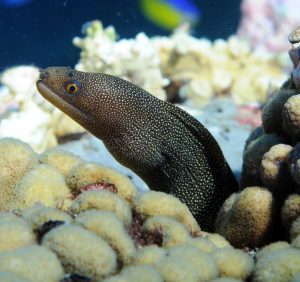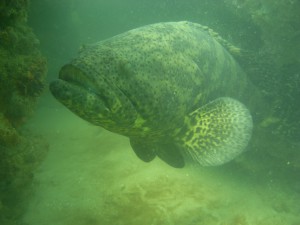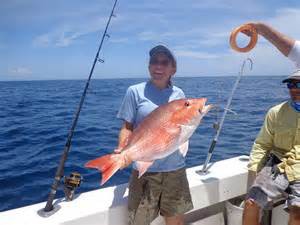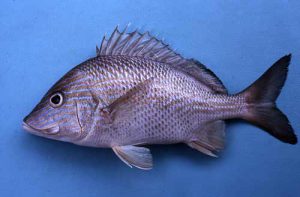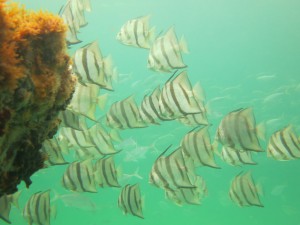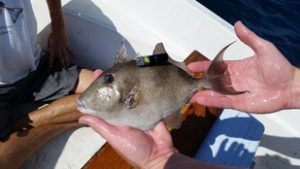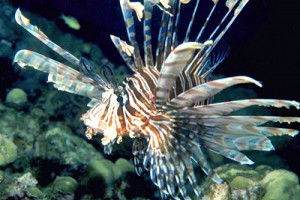When most people think of reefs, they think of the coral reefs of the Florida Keys and Australia. But here in the northern Gulf the winters are too cold for many species of corals to survive. Some can, but most cannot and so we do not have the same type of reefs here.
That said, we do have reefs. We have both natural and artificial reefs. There are natural reefs off Destin and a large reef system off the coast of Texas – known as the “Flower Gardens”. Here the water temperatures on the bottom are warm enough to support some corals. The artificial reef program along the northern Gulf is one of the more extensive ones found anywhere. There is a science to designing an artificial reef – you do not just go out and dump whatever – because if not designed correctly, you will not get the fish assemblages and abundance you were hoping for. But if you do… they will come.
Reefs are known for their high diversity and abundance of all sorts of marine life – including fishes. There are numerous places to hide and plenty of food. Most of the fish living on the reef are shaped so they can easily slide in and out of the structure, have teeth that can crush shell – the parrotfish can actually crush and consume the coral itself, and some can be fiercely territorial. There are numerous tropical species that can be found on them and they support a large recreational diving industry. Let’s look at a few of these reef fish.
Moray Eels
These are fish of legend. There all sorts of stories of large morays, with needle shaped teeth, attacking divers. Some can get quite large – the green moray can reach 8-9 feet and weigh over 50 pounds. Though this species is more common in the tropics, it has been reported from some offshore reefs in the northern Gulf. There are three species that reside in our area: the purplemouth, the spotted, and the ocellated morays. The local ones are in the 2-3 foot range and have a feisty attitude – handle with care – better yet… don’t handle. They hide in crevices within the reef and explode on passing prey, snagging them with their sharp teeth. Many divers encounter them while searching these same crevices for spiny lobster. There are probing sticks you can use so that you do not have to stick your hand in there. There are rumors that since they have sharp teeth and tend to bite, they are venomous – this is not the case, but the bite can be painful.
Groupers
This word is usually followed by the word “sandwich”. One of the more popular food fish, groupers are sought by anglers and spearfishermen alike. They are members of the serranid family (“sea basses”). This is one of the largest families of fishes in the Gulf – with 34 species listed. 15 of these are called “grouper” and there have been other members of this family sold as “grouper”.
So, what is – or is not – a “grouper”. One method used is anything in the genus Epinephelus would be a grouper. This would include 11 species, but would leave out the Comb, Gag, Scamp, Yellowfin, and Black groupers – which everyone considers “grouper”. Tough call eh?
These are large bodied fish with broad round fins – the stuff of slowness. That said, they can explode, just like morays, on their prey. Anglers who get a grouper hit know it, and divers who spear one know it. They range in size from six inches to six feet. The big boy of the group is the Goliath Grouper (six feet and 700 pounds). They love structure – so natural and artificial reefs make good homes for them. They also like the oil rigs of the western Gulf.
An interesting thing about many serranids is the fact they are hermaphroditic – male and female at the same time. Most grouper take it a step further – they begin life as females and become males over time.
Snappers
The red snapper is king. Prized as a food fish all over the United States, and beyond, these fish have made commercial fishermen very happy. With an average length of 2.5 feet, some much larger individuals have been landed. This fishery put Pensacola on the map in the early 20th century. Sailing vessels called “Snapper Smacks” would head out to the offshore banks and natural reefs, return with a load, and sell both locally and markets in New York. There are large populations in Texas waters and down on the Campeche Banks off Mexico. “Snapper Season” is a big deal around here.
Though these are reef fish, snapper have a habit of feeding above, and away from, them. You probably knew there was more than one kind of snapper but may not know there are 10 species locally. Due to harvesting pressure, there are short seasons on the famous red snapper – so vermillion snapper has stepped in as a popular commercial fishery – and it is very good also. Some, like the gray snapper, are more common inshore around jetties and seawalls. Also known as the black snapper or mangrove snapper, this fish can reach about three feet in length and make a good meal as well.
Grunts
Grunts look just like snapper, and probably sold as them somewhere. But they are a different family. They lack the canines and vomerine teeth the snappers have – other than that, they do look like snapper. Easy to tell apart right? Vomerine are tiny teeth found in the roof of the mouth, in snappers they are in the shape of an arrow. They get their name from a grunting sound they make when grinding their pharyngeal teeth together. A common inshore one is called the “pigfish” because of this. They do not get as large as snapper (most are about a foot long) and are not as popular as a food fish, but the 11 known species are quite common on the reefs, and the porkfish is one of the more beautiful fish you will see there.
Spadefish
This is one of the more common fish found around our reefs. Resembling an angelfish, they are often confused with them – but they are in a family all to themselves. What is the difference you ask? The dorsal fin of the spade fish is divided into two parts – one spiny, the other more fin-like. In the angelfish, there is only one continuous dorsal fin.
Spadefish like to school and are actually good to eat. It is also the logo/mascot of the nearby Dauphin Island Sea Lab.
Triggerfish
“Danger Will Robinson!” This fish has a serious set of teeth and will come off the reef and bite through a quarter inch wetsuit to defend their eggs. Believe it – they are not messing around. Once considered a by-catch to snapper fishermen, they are now a prized food fish. They are often called “leatherjackets” due to their fused scales forming a leathery like skin that must be cut off – no scaling with this fish. They have the typical tall-flat body of a reef fish, squeezing through the rocks and structure to hide or hunt. We have five species listed in the Gulf of Mexico, but it is the Gray Triggerfish that is most often encountered.
Lionfish
You may, may not, have heard of this one – most have by now. It is an invader to our reefs. To be an invasive species you must #1 be non-native. The lionfish is. There are actually about 20 species of lionfish inhabiting either the Indo-Pacific or the Red Sea region.
#2 have been brought here by humans (either intentionally or unintentionally – but they did not make it on their own) – this is the case with the lionfish. It was brought here for the aquarium trade. There are actually two species brought here: The Red Lionfish (Pterois volitans) and the Devilfish (Pterois miles). Over 95% of what has been captured are the red lionfish – but it really does not matter, they look and act the same – so they are just called “lionfish”.
#3 they must be causing an environmental, and/or an economic problem. Lionfish are. They have a high reproductive rate – an average of 30,000 offspring every four days. There is science that during sometimes of the year it could be higher, also they breed year-round. Being an invasive species, there are few predators and so the developing young (encapsulated in a gelatinous sac) drift with the currents to settle on new reefs where they will eat just about anything they can get into their mouths. There have been no fewer than 70 species of small reef fish they have consumed – including the commercially valuable vermillion snapper and spiny lobster. There is now evidence they are eating other lionfish.
They quickly take over a reef area and some of the highest densities in the south Atlantic region have been reported off Pensacola. However, at a 2018 state summit, researchers indicated that the densities in our area have declined in waters less than 200 feet. This is most probably due to the harvesting efforts we have put on them. They are edible – actually, quite good, and there is a fishery for them. Derbies and ecotours have been out spearfishing for them since 2010. You may have heard they were poisonous and dangerous to eat. Actually, they are venomous, and the flesh is fine. The venom is found in the spines of the dorsal, pelvic, and anal fins. It is very painful, but there are no records of anyone dying from it. Work and research on management methods continue.
- Rattlesnakes on Our Barrier Islands; Part 4 – Thermoregulation - December 29, 2025
- Rattlesnakes on Our Barrier Islands; Part 3 – Envenomation - December 22, 2025
- St. Joe Red Tide Claiming Terrapins - December 15, 2025

